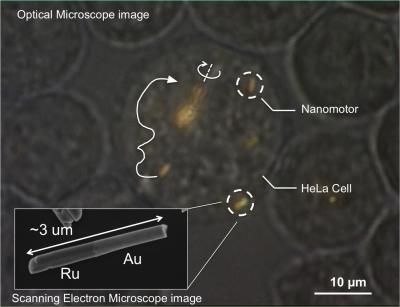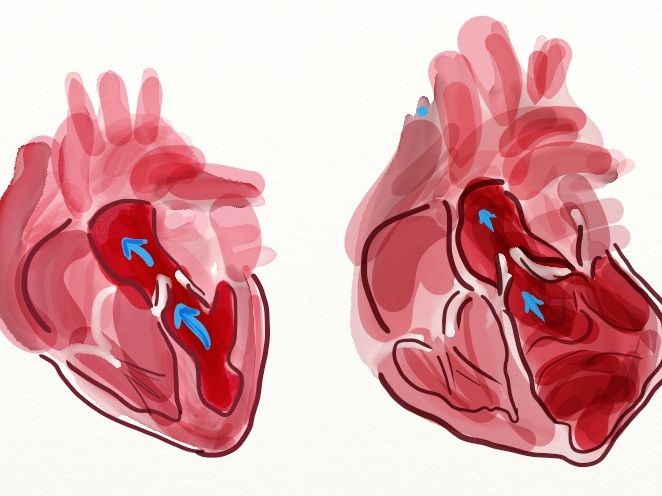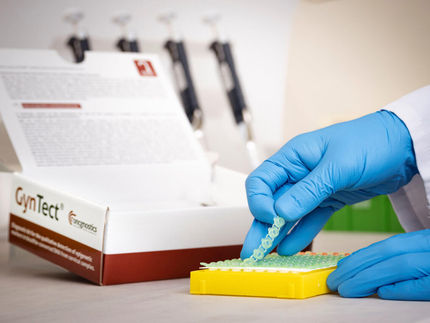Nanomotors are controlled, for the first time, inside living cells
For the first time, a team of chemists and engineers at Penn State University have placed tiny synthetic motors inside live human cells, propelled them with ultrasonic waves and steered them magnetically. It's not exactly "Fantastic Voyage," but it's close. The nanomotors, which are rocket-shaped metal particles, move around inside the cells, spinning and battering against the cell membrane.

Optical microscope image of a HeLa cell containing several gold-ruthenium nanomotors. Arrows indicate the trajectories of the nanomotors, and the solid white line shows propulsion. Near the center of the image, a spindle of several nanomotors is spinning. Inset: Electron micrograph of a gold-ruthenium nanomotor. The scattering of sound waves from the two ends results in propulsion.
Mallouk lab, Penn State University
"As these nanomotors move around and bump into structures inside the cells, the live cells show internal mechanical responses that no one has seen before," said Tom Mallouk, Evan Pugh Professor of Materials Chemistry and Physics at Penn State. "This research is a vivid demonstration that it may be possible to use synthetic nanomotors to study cell biology in new ways. We might be able to use nanomotors to treat cancer and other diseases by mechanically manipulating cells from the inside. Nanomotors could perform intracellular surgery and deliver drugs noninvasively to living tissues."
The researchers' findings will be published in Angewandte Chemie International Edition. In addition to Mallouk, co-authors include Penn State researchers Wei Wang, Sixing Li, Suzanne Ahmed, and Tony Jun Huang, as well as Lamar Mair of Weinberg Medical Physics in Maryland U.S.A.
Up until now, Mallouk said, nanomotors have been studied only "in vitro" in a laboratory apparatus, not in living human cells. Chemically powered nanomotors first were developed ten years ago at Penn State by a team that included chemist Ayusman Sen and physicist Vincent Crespi, in addition to Mallouk. "Our first-generation motors required toxic fuels and they would not move in biological fluid, so we couldn't study them in human cells," Mallouk said. "That limitation was a serious problem." When Mallouk and French physicist Mauricio Hoyos discovered that nanomotors could be powered by ultrasonic waves, the door was open to studying the motors in living systems.
For their experiments, the team uses HeLa cells, an immortal line of human cervical cancer cells that typically is used in research studies. These cells ingest the nanomotors, which then move around within the cell tissue, powered by ultrasonic waves. At low ultrasonic power, Mallouk explained, the nanomotors have little effect on the cells. But when the power is increased, the nanomotors spring into action, moving around and bumping into organelles -- structures within a cell that perform specific functions. The nanomotors can act as egg beaters to essentially homogenize the cell's contents, or they can act as battering rams to actually puncture the cell membrane.
While ultrasound pulses control whether the nanomotors spin around or whether they move forward, the researchers can control the motors even further by steering them, using magnetic forces. Mallouk and his colleagues also found that the nanomotors can move autonomously -- independently of one another -- an ability that is important for future applications. "Autonomous motion might help nanomotors selectively destroy the cells that engulf them," Mallouk said. "If you want these motors to seek out and destroy cancer cells, for example, it's better to have them move independently. You don't want a whole mass of them going in one direction."
The ability of nanomotors to affect living cells holds promise for medicine, Mallouk said. "One dream application of ours is Fantastic Voyage-style medicine, where nanomotors would cruise around inside the body, communicating with each other and performing various kinds of diagnoses and therapy. There are lots of applications for controlling particles on this small scale, and understanding how it works is what's driving us."
Most read news
Organizations

Get the analytics and lab tech industry in your inbox
By submitting this form you agree that LUMITOS AG will send you the newsletter(s) selected above by email. Your data will not be passed on to third parties. Your data will be stored and processed in accordance with our data protection regulations. LUMITOS may contact you by email for the purpose of advertising or market and opinion surveys. You can revoke your consent at any time without giving reasons to LUMITOS AG, Ernst-Augustin-Str. 2, 12489 Berlin, Germany or by e-mail at revoke@lumitos.com with effect for the future. In addition, each email contains a link to unsubscribe from the corresponding newsletter.
More news from our other portals
Last viewed contents
Revolutionary imaging technique uses CRISPR to map DNA mutations

‘Artificial tongue’ detects and inactivates common mouth bacteria - In the future, bacterial dental diseases could also be diagnosed and treated using this sensor system



























































